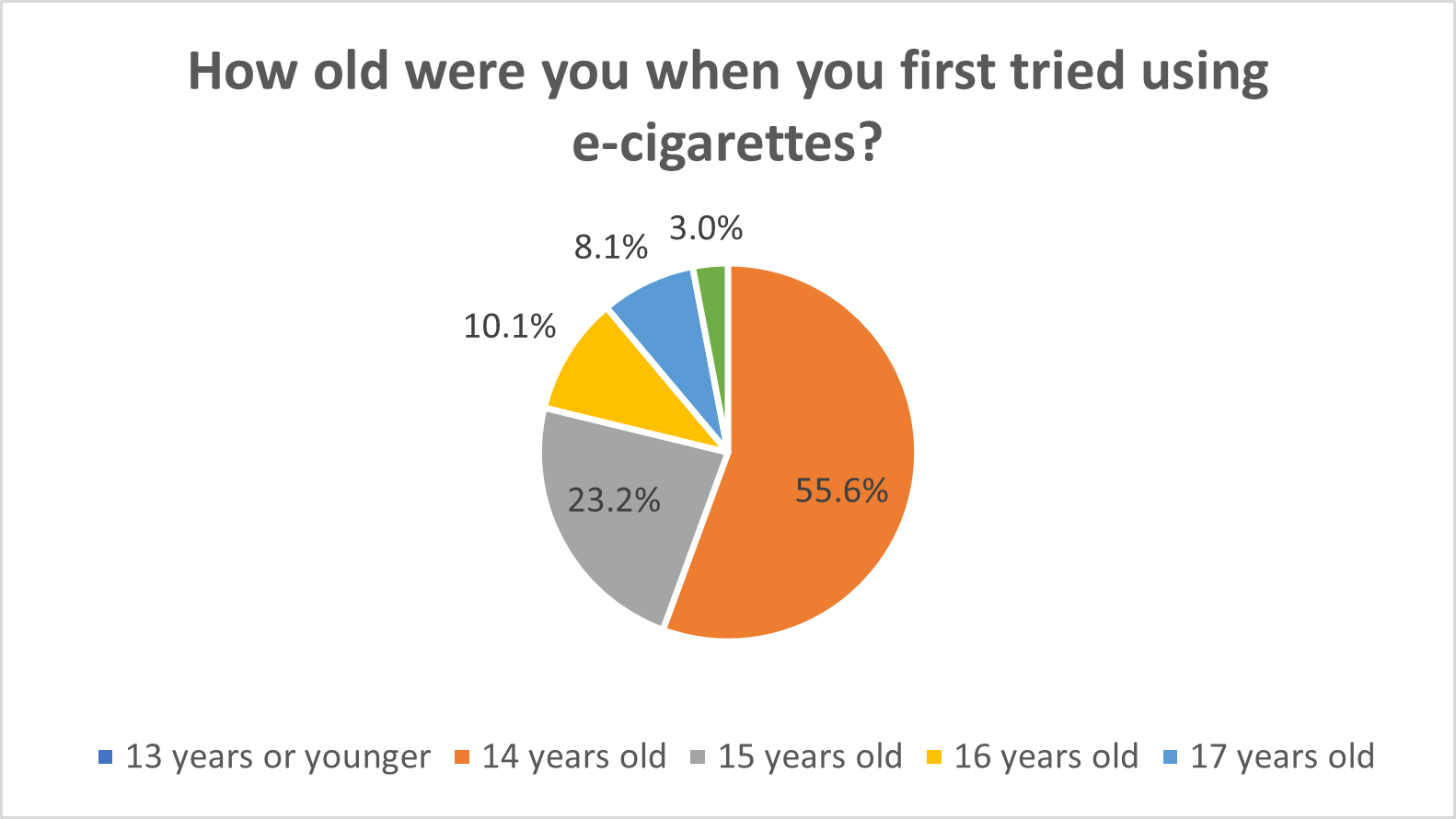Vaping use among Michigan youth
Understanding the prevalence, risks and prevention efforts surrounding youth vaping in Michigan.

E-cigarette use, commonly referred to as vaping, happens all around us. Vaping has become common practice among adults and youth in a variety of settings, such as parks, restaurants, sporting events, public restrooms, shopping centers, schools, driving and even public transportation. Targeted advertising, easy accessibility and social influences have contributed to the significant public health concern of vaping use among youth.
According to the Michigan Department of Health and Human Services’ 2023 Michigan Youth Tobacco Survey, 16.5% of Michigan high school students currently use tobacco, with 13.7% of those students using via e-cigarettes. Michigan youth's e-cigarette use is slightly below the national average of 14.1%. Strikingly, 55.6% of youths surveyed reported trying e-cigarettes for the first time at 13 years of age or younger.

Pie chart: “How old were you when you first tried using e-cigarettes?” Statistics from 2023 Michigan Youth Tobacco Survey
What are vapes?
Vapes are devices that use heat to convert liquid into an aerosol, which the user inhales into their lungs. People use a variety of different names to refer to vapes, such as vape pens, tanks, mods, e-cigs or electronic delivery systems (ENDS).
According to the Centers for Disease Control and Prevention, there are multiple varieties of vapes, including ones that are disposable, refillable and have pre-filled cartridges or pods. Vapes are extremely versatile, available in a variety of flavors, shapes and sizes. They can resemble everyday items like toys, pens, USB drives, smart phone cases and smartwatches. They can also be integrated into clothing items like hoodies or jackets, appealing to different demographics. Youth find these attributes highly attractive and the variety of options makes them easy to conceal
The impact of vaping on youth health outcomes?
Youth are exposed to several health risks from vaping, including:
- Interference with brain development.
- Exposure negatively impacts attention and concentration, learning, academic performance and impulse control.
- Mental health
- Vaping has been linked to an increase in anxiety and depression in youth, which affects mood regulation and leads to mood swings.
- Respiratory and pulmonary health
- Lung health can be adversely impacted by smoking, with the potential for chronic bronchitis, respiratory problems, severe lung injury and death.
- Cardiovascular health
- Vaping can result in an increase in heart rate and blood pressure, which can lead to long-term cardiovascular issues and damage blood vessels.
- Nicotine addiction
- Vapes commonly contain nicotine, which can be very addictive and lead to dependence.
- Exposure to toxic substances
- Formaldehyde and heavy metals are present in e-cigarette aerosol, which can have a negative effect on health.
Access to tobacco and e-cigarettes
Access to tobacco and e-cigarettes remains alarmingly easy for youth to access. Most youths, approximately 40%, report buying a vape from a friend, 12% from a family member and 13.2% from gas stations or convenience stores. When trying to buy cigarettes, only 9% of youth were turned down. When buying e-cigarettes, that number was even lower at just 5%.
MSU Extension’s efforts in vaping prevention
With the increase of use and ease of access in obtaining vapes, Michigan State University Extension is dedicated to educating Michigan’s youth about the risks associated with substance use and vaping. MSU Extension was awarded a $450,000 three-year Health Rocks! grant from National 4-H Council to provide substance use prevention education to youth ages 8-14 across Michigan. More information on this important initiative can be found in a recent MSU Extension article. To learn more or to get your organization involved with Health Rocks! program, email piconeal@msu.edu.
Resources for youth, parents/guardians and educators
The CDC encourages parents, guardians and youth to learn more about e-cigarettes, through the following resources:
- Youth resources
- Parent and guardian resources
- Resources for educators, coaches and school administrators
Visit the 4-H Healthy Youth website to learn more about 4-H healthy living programs for youth and the related article From cigarettes to e-cigarettes: The evolution of tobacco use in the United States.



 Print
Print Email
Email




